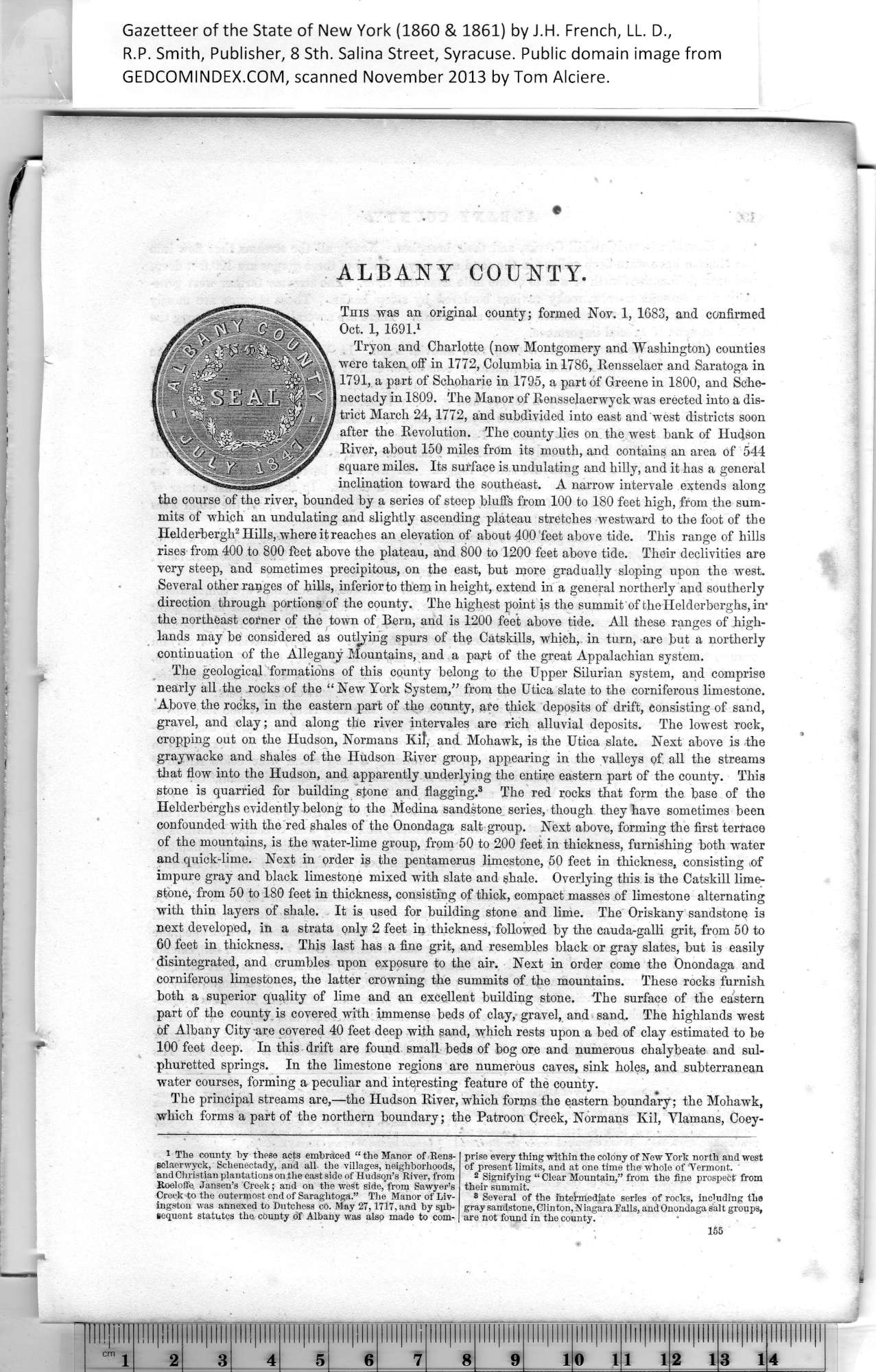|
ALBANY COUNTY.
This was an original county: formed Nov. 1, 1683, and confirmed
Oct. 1, 1691.1
Tryon and Charlotte (now Montgomery and Washington) counties
were taken off in 1772, Columbia in 1786, Rensselaer and Saratoga in
1791, a part of Schoharie in 1795, a part of Greene in 1800, and Sche¬
nectady in 1809. The Manor of Rensselaerwyck was erected into a dis¬
trict March 24,1772, and subdivided into east and west districts soon
after the Revolution. The county lies on the west bank of Hudson
River, about 150 miles from its mouth, and contains an area of 544
square miles. Its surface is undulating and hilly, and it has a general
inclination toward the southeast. A narrow intervale extends along
the course of the river, bounded by a series of steep bluffs from 100 to 180 feet high, from the sum¬
mits of which an undulating and slightly ascending plateau stretches westward to the foot of the
Helderbergh2 Hills, where it reaches an elevation of about 400 feet above tide. This range of hills
rises from 400 to 800 feet above the plateau, and 800 to 1200 feet above tide. Their declivities are
very steep, and sometimes precipitous, on the east, but more gradually sloping upon the west.
Several other ranges of hills, inferior to them in height, extend in a general northerly and southerly
direction through portions of the county. The highest point is the summit of the Helderberghs, in’
the northeast corner of the town of Bern, and is 1200 feet above tide. All these ranges of high¬
lands may be considered as outlying spurs of the Catskills, which, in turn, are but a northerly
continuation of the Allegany Mountains, and a part of the great Appalachian system.
The geological formations of this county belong to the Upper Silurian system, and comprise
nearly all the rocks of the “ New York System,” from the Utica slate to the corniferous limestone.
Above the rocks, in the eastern part of the county, are thick deposits of drift, consisting of sand,
gravel, and clay; and along the river intervales are rich alluvial deposits. The lowest rock,
cropping out on the Hudson, Normans Kil, and Mohawk, is the Utica slate. Next above is the
graywacke and shales of the Hudson River group, appearing in the valleys of. all the streams
that flow into the Hudson, and apparently underlying the entire eastern part of the county. This
stone is quarried for building stone and flagging.3 The red rocks that form the base of the
Helderberghs evidently belong to the Medina sandstone series, though they have sometimes been
confounded with the red shales of the Onondaga salt group. Next above, forming the first terrace
of the mountains, is the water-lime group, from 50 to 200 feet in thickness, furnishing both water
and quick-lime. Next in order is the pentamerus limestone, 50 feet in thickness, consisting of
impure gray and black limestone mixed with slate and shale. Overlying this is the Catskiil lime¬
stone, from 50 to 180 feet in thickness, consisting of thick, compact masses of limestone alternating
with thin layers of shale. It is used for building stone and lime. The Oriskany sandstone is
next developed, in a strata only 2 feet in thickness, followed by the cauda-galli grit, from 50 to
60 feet in thickness. This last has a fine grit, and resembles black or gray slates, but is easily
disintegrated, and crumbles upon exposure to the air. Next in order come the Onondaga and
corniferous limestones, the latter crowning the summits of the mountains. These rocks furnish
both a superior quality of lime and an excellent building stone. The surface of the eastern
part of the county is covered with immense beds of clay, gravel, and sand. The highlands west
of Albany City are covered 40 feet deep with sand, which rests upon a bed of clay estimated to be
100 feet deep. In this drift are found small beds of bog ore and numerous chalybeate and sul¬
phuretted springs. In the limestone regions are numerous caves, sink holes, and subterranean
water courses, forming a peculiar and interesting feature of the county.
The principal streams are,—the Hudson River, which forms the eastern boundary; the Mohawk,
which forms a part of the northern boundary; the Patroon Creek, Normans Kil, Ylamans, Coey-
|
prise every thing within the colony of New Tork north and west
of present limits, and at one time the whole of Vermont.
2 Signifying “ Clear Mountain,” from the fine prospect from
their summit.
8 Several of the intermediate series of rocks, including the
gray sandstone, Clinton, Niagara Ralls, and Onondaga salt groups,
are not found in the county. |
|
